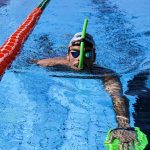Are you ready to push your limits and conquer the ultimate endurance challenge? The triathlon is a grueling race that combines swimming, cycling, and running into one epic event. But what if you don’t have access to a pool for training?
In this blog post, we’ll delve into the world of training for a triathlon without access to a pool. Whether it’s due to pool closures or your personal preference for open water, our tips and tricks will help you prepare for the swim portion of your triathlon. From alternative workouts that build swim endurance to mental preparation techniques, we’ll cover everything you need to know.
So grab your goggles and let’s dive into the world of triathlon training without a pool.
- Discover creative alternatives for building swim endurance
- Master mental strategies for an open water swim
- Incorporate dryland exercises into your training routine
- Find nearby open water locations with our helpful tips
- Prepare yourself for any situation with our troubleshooting guide
Table of Contents
How Can You Swim Without Water?
Absolutely. Here are five alternative methods that can help you prepare for the swim portion of a triathlon:
- Open Water Swimming: Instead of a pool, find a nearby lake, river, or ocean to practice in. Not only will this improve your endurance, but it will also simulate race conditions. Gradually increase your distance and time spent in the water for optimal results.
- Swim Tethers: Attach elastic bands to a stationary object, such as a pole or tree, to mimic swimming movements. This is an effective way to work on your stroke technique and build strength and endurance.
- Resistance Training: Strengthening the muscles used in swimming can greatly improve your performance. Incorporate exercises like squats, lunges, push-ups, and lat pulldowns into your routine to target key muscle groups.
- Dryland Drills: Improve your swimming performance by incorporating specific exercises that can be done on land. These include core stability exercises, rotation drills, and arm strength exercises like burpees, t-rotation pushups, and reaching lunges.
- Cross-Training: Don’t limit yourself to just swimming-specific training methods. Activities like running, cycling, and strength training can also be beneficial for preparing for a triathlon without access to a pool. They can improve overall fitness level and prevent boredom by adding variety to your training routine.
It’s important to have a well-rounded training program that utilizes multiple methods when preparing for the swim portion of a triathlon without access to a pool. Online resources can provide guidance on improving swimming technique without a coach.
If open water is not accessible, focus on alternative methods such as swim tethers or dryland drills and incorporate cross-training activities.
Dryland Workouts for Swimmers
For swimmers, maintaining their swimming fitness and skills is crucial, even when they don’t have access to a pool. In addition to swimming, dryland workouts can be incorporated into triathlon training to help target specific muscles and improve overall strength and endurance. These workouts include resistance band pulls, medicine ball sit-ups with twists, jumping drills, and resistance training.
To ensure a successful triathlon performance, it is important to maintain proper form while doing these exercises. Gradually increasing intensity is also key to avoiding injury and achieving maximum benefits. Consistency is key in incorporating these workouts into your training routine.
One of the most effective dryland exercises for swimmers is resistance band pulls. This exercise targets the muscles used in swimming and helps improve strength and endurance. It also helps with body position and alignment, which are essential for efficient swimming technique.
Another great exercise is medicine ball sit-ups with twists. This exercise not only works on core strength but also helps with rotational power, which is important for generating force in the water during swimming. Jumping drills are also beneficial for swimmers as they work on explosive power and leg strength, which are crucial for a strong kick in the water.
For overall strength and conditioning, resistance training can be incorporated into dryland workouts for swimmers. This includes exercises such as squats, lunges, and deadlifts, which target multiple muscle groups and help improve overall athletic performance.
Excell with These Swimming Dryland Workouts
Triathlon is a demanding sport that requires swimmers to be strong, powerful, and flexible. Unfortunately, not everyone has access to a pool for training.
There are still plenty of dryland workouts that can help you prepare for your next triathlon. Resistance band training, circuit training, core exercises, yoga, and plyometrics are all effective options for building strength, endurance, and power.
These workouts will not only help you maintain your swimming fitness and skills but also simulate the intensity of a triathlon race.

Resistance band training is an excellent way to target specific muscle groups and improve overall strength. The bands provide resistance throughout the entire range of motion, making them a great alternative to traditional weights. Circuit training, on the other hand, is a high-intensity workout that combines strength and cardio exercises. This type of training is perfect for improving endurance and simulating the demands of a triathlon race.
Core exercises, such as planks and Russian twists, are essential for building a strong core and improving stability in the water. Yoga is another great option for triathletes as it helps improve flexibility, balance, and mental focus. Plus, it’s a great way to relax and recover after intense training sessions.
Plyometrics involve explosive movements that help build power and speed. These types of exercises are especially beneficial for swimmers as they mimic the quick bursts of energy required during a triathlon race. By incorporating these various dryland workouts into your training routine, you can improve your overall performance and become a more well-rounded triathlete.
Remember to mix up your workouts, vary your intensity levels, and always listen to your body. With consistent dryland training, you’ll be well on your way to excelling in your next triathlon competition.
Conclusion
In conclusion, tackling a triathlon without access to a pool may seem like an insurmountable task, but with the right mindset and techniques, it can be achieved.
By incorporating alternative methods such as open water swimming, swim tethers, resistance training, dryland drills, and cross-training into your routine, you can effectively prepare for the swim portion of a triathlon. It’s crucial to have a well-rounded training program that targets specific muscles and improves overall strength and endurance.
Moreover, incorporating dryland workouts such as resistance band pulls, medicine ball sit-ups with twists, jumping drills, circuit training, core exercises, yoga, and plyometrics can greatly benefit swimmers in their triathlon journey. Remember to vary your workouts and listen to your body while gradually increasing intensity levels.
With consistency and determination, you will be ready to conquer the ultimate endurance challenge of a triathlon without relying on a pool. So grab your goggles and get ready to push yourself beyond your limits.






